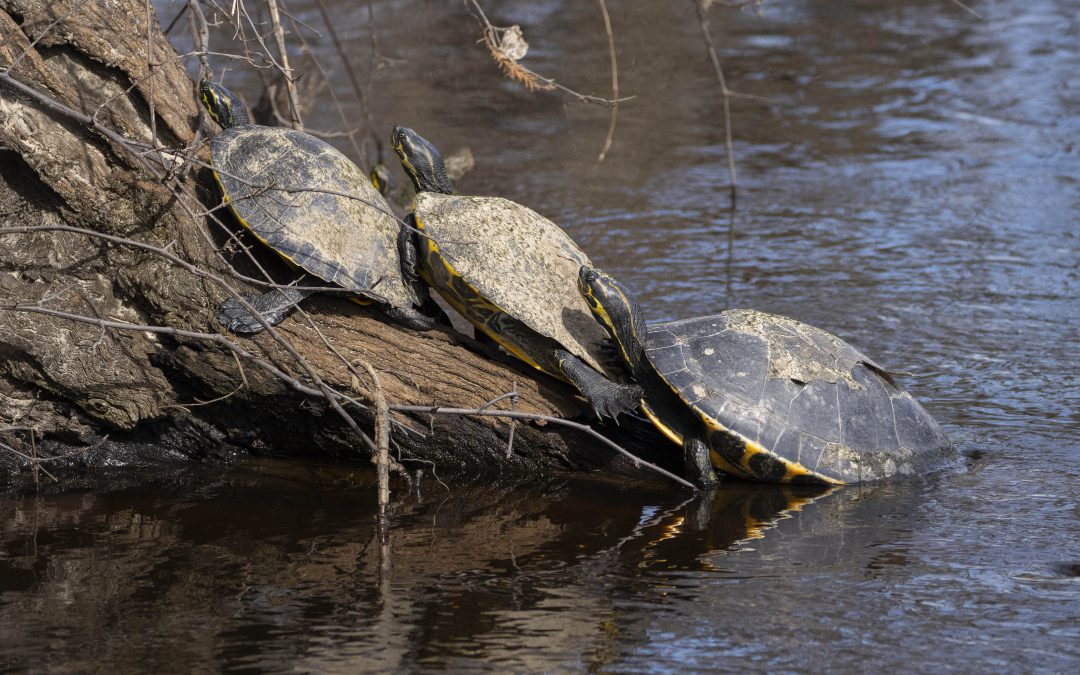
by Rick O'Connor | May 13, 2022
The Florida panhandle has one of rich biodiversity. This goes for the variety of turtles found here as well. Many paddlers and hikers to our waterways see these turtles but have trouble identifying which they are looking. In response to request by outdoor adventures wanting to learn more, UF IFAS Extension will be offering a one day workshop on field identification of panhandle riverine turtles.
The workshop will be held this Monday – May 16, 2022 – in Apalachicola FL. Participants will attend a classroom session where the biogeography of our turtles will be discussed and visual identification will be practiced. We will then take a boat ride up the Apalachicola River and practice in the field.
The program will begin at 8:30am (ET) at the Franklin County Extension Office. The cost will be $25 and preregistration is required. You can register at https://riverine_turtles_florida_panhandle.eventbrite.com/
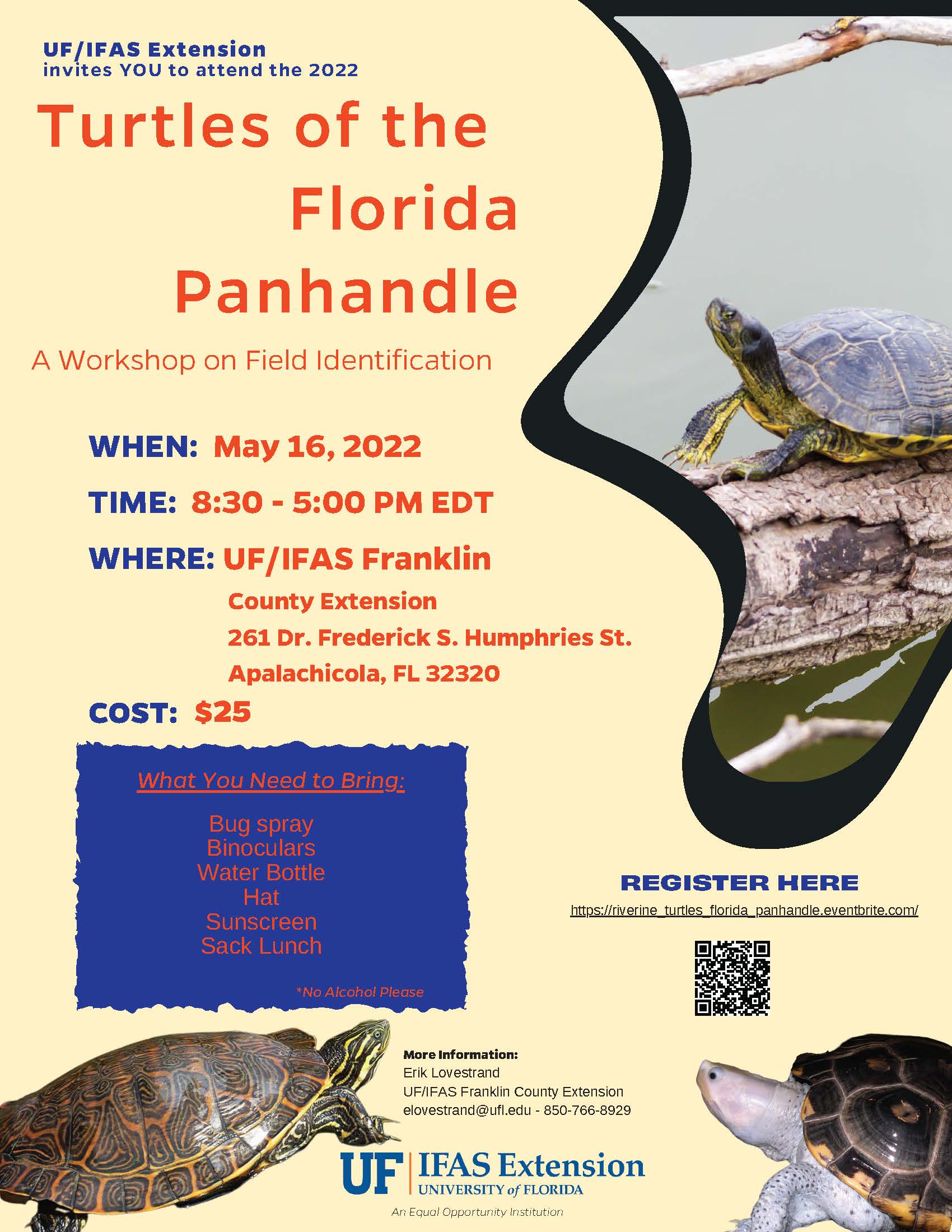
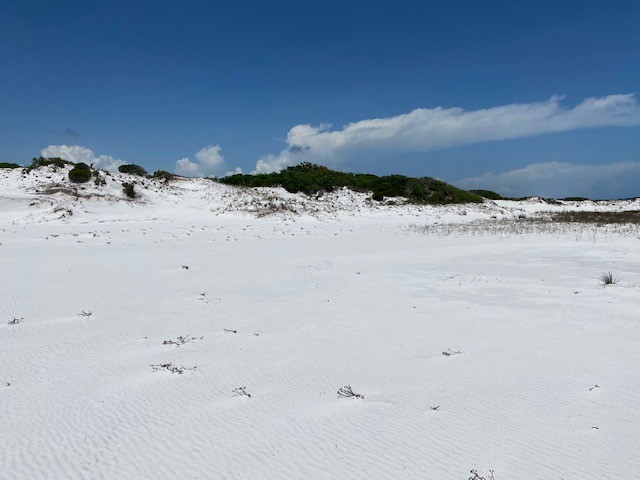
by Rick O'Connor | May 13, 2022
It is mid-spring and time of nesting for much of the wildlife in the area. It is also noticeably warmer than our previous hikes. Due to my work schedule, and the surveys for other nesting activity, I did this hike earlier in the month and later in the day, than I typically would have. I began my hike at 1:00pm – near the hottest part of the day, and not the best time to see wildlife, but I definitely wanted to get a hike in this month and so this is when I could.
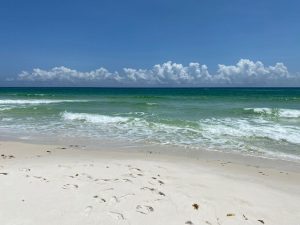
The Gulf was relatively calm on this early afternoon in spring.
It was warm. On this day it was 83°F and there was a light breeze from the southeast. On the previous hikes I needed my fleece. Though I had it in my backpack, I did not need it today. My hike was at Big Sabine and as usual, I began on the Gulf of Mexico. The first thing I noticed when I crossed over the boardwalk was the number of people. I usually hike in the early morning or late afternoon and see few humans. But at mid-day the beach was full of people, and I probably looked strange walking among them with my long pants, long sleeved shirt, and boots. The second thing I noticed was mats of Sargassum on the beach.
Sargassum is a floating brown algae we see in the warmer months in our part of the Gulf. It is first an algae, not a true plant. Algae lack roots, stems, and leaves. They produce no cones, fruit nor flowers with seeds. They are nonvascular, meaning they lack a system of vein-like tubes that move water around the plant. Plants usually do have these tubes. They are not called arteries and veins as they are in animals, but rather xylem and phloem. Because algae lack this circulation system, they live emersed in the water. Since they lack true roots they anchor to hard substrate, like rocks and coral, using a suction type apparatus called a holdfast. The flexible, herbaceous stipe, analogous to the stem, flows in the current extending their blades (analogous to leaves) into the light. Like plants, algae require water, carbon dioxide, and sunlight to photosynthesize their food. Because of this they need to live in relatively shallow water, and they need a rocky bottom to attach their holdfast to. We have little hard bottom and therefore less of the classic algae you read about in other parts of the world.
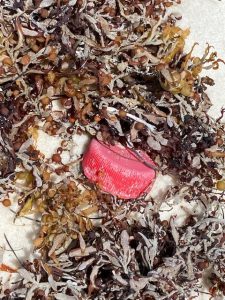
Notice the small air bladders on this Sargassum weed. These are used by the algae to remain near the sunlit waters of the open Gulf.
Sargassum has a different plan to deal with this problem. They float. When you look at this seaweed on the beach you will notice they have numerous small circular air bladders called pneumatophores. These air bladders allow Sargassum to float in the sunlit waters of the Gulf and not worry about how, or where, they would attach their holdfast.
Large mats of Sargassum can be found floating out in the open Gulf and these mats provide a fantastic habitat for many small and large marine creatures. There are sargassum crabs, sargassum shrimp, and even a sargassum sea horse. There is a small filefish and a frogfish known as the sargassum fish. It is the target for baby sea turtles that successfully made it from the beach, through the surf, and into the open Gulf without being consumed. Here they will live and feed for many months at which time they are large enough to venture back out. Larger fish often seek out these mats searching for food, and fishermen seek the mats knowing that larger fish are probably in the area.
These mats of Sargassum get caught in the large ocean currents and find their way to the middle of the Atlantic. Here the ocean is calm, like the eye of a hurricane, and huge mats of Sargassum can be found piled up. Christopher Columbus found this massive expanse of Sargassum while crossing the Atlantic. Because it was calm here, and the Sargassum so thick, his ships became becalmed and he noted in his log to avoid this place, which was then called the “Sargasso Sea”.
On today’s hike there was quite a bit of this seaweed washed ashore. Most of the marine life living in the seaweed sense the waves and the impending beaching, and jettison for mats further offshore. So, you usually do not find many creatures in the seaweed washed ashore, but sometimes you do. You can take a small dip net out deeper and grab some still floating and you may have better luck. Today, I explored what was washed ashore and did not find much. I did find a lot of plastic, and those who study Sargassum ecology will tell there is a lot of plastic debris caught up in the Sargassum mats. Today I noticed a lot of bottle caps. Not many bottles, but lots of bottle caps. As many others do, we encourage everyone to dispose of the garbage properly. I read this week of a manatee found near Mobile Bay earlier this year who died of cold stress but had swallowed a plastic bag, which was caught in his throat. Marine debris kills. Please dispose of your trash properly.
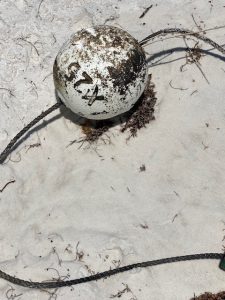
This crab pot float was one of several debris items washed in with the sargassum.
Heading inland to the dune field I heard sirens. The beach patrol was answering a call. I am not sure where, nor what the issue was, but these again are sounds I do not usually hear when hiking early and late in the day. There are currents in the Gulf that can suck you out to sea, and each year we have visitors drown not knowing where these currents are, or how to get out of them if they are caught in one. Pay attention to the colored flags and be careful. I never saw, nor heard, an ambulance follow the beach patrol. So, I am guessing everyone was okay on this call.
The dune field on this May afternoon was warm. There was a light breeze from the southeast that kept things from getting too warm, but it was warm none the less. As we move closer the hot days of summer the wildlife will move more at dawn and dusk, as well as in the evening. I was not expecting to see a lot on this hike.
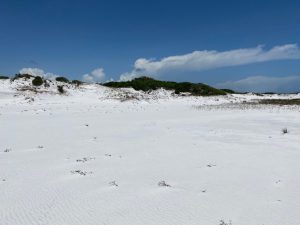
This flat area of the dune field was quite warm on this afternoon and made me think of crossing a desert.
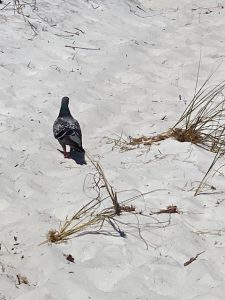
This was an unusual site, a pigeon walking in the open dune field.
As always you can see what has been moving by searching for tracks and tracks, I did find. Many of them were human, indicating the tourist season is upon us, but there were tracks of animals as well. There were plenty from our friends the raccoon and armadillo. I did notice more raccoon tracks this month. I and my volunteers who survey nesting beaches notice more raccoon tracks this time of year looking for eggs. I also noticed more snake tracks on this hike, they too are mating and moving much more. The lizard tracks were fresh, and I have noticed these moving during the warmer parts of the day and their tracks running across the dune face told me they were very busy that day.
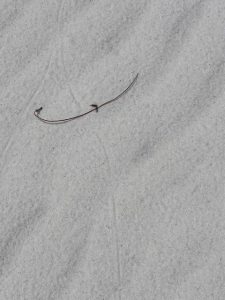
This straight line the sign of a tail drag by a lizard, most likely the six-lined skink.
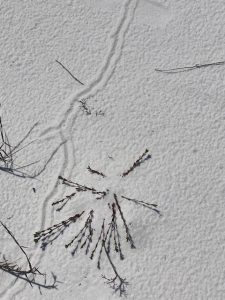
Many who visit the dunes of our barriers find these burrow looking trails. These are made by beetles.
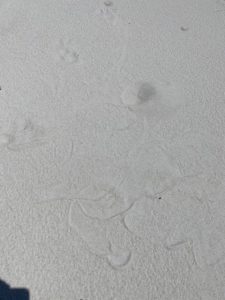
I followed this snake track until I found this – what appears to be a “tussle” the snake had with a possible prey.
Being spring you would expect flowers, and there were some, just not as many as you might expect. Most of them were white and were blooming on plants near the boggy areas of the swales. The conradina that blooms more in the winter, was done and the blossoms were gone. I did see the early stages of the magnolia flowers trying to come up, but the bright green shoots of new growth on the pines were not visible. There were bees, lots of bees.
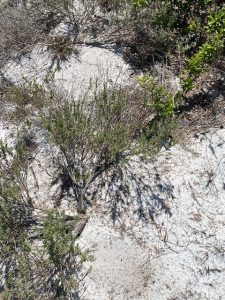
The lavender blossoms of the false rosemary, which appeared in winter, are now gone.

White flowers were common on this spring afternoon. Such as this one on the spiny bull nettle.
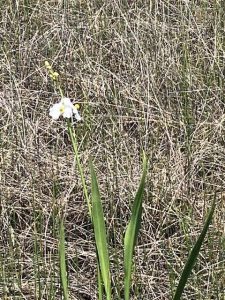
Another white flower is seen on this Sagittaria growing in one of the swales between dunes.
I hiked through a small pine scrub area thinking I might someone in the shade avoiding the heat of the day but did not find anything. I went along the edge of the tertiary dunes where they meet the maritime forest looking for the same thing. Nothing, but there were tracks. The cactus seemed to be more abundant this month.
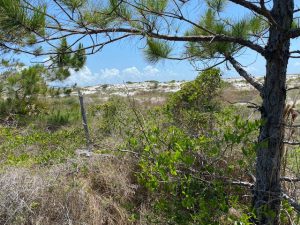
The pine scrub offered one of the few places with shade.
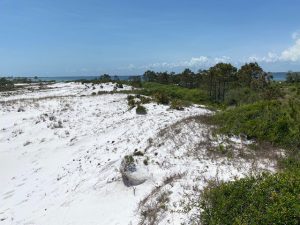
The dune field of a Florida panhandle barrier island.
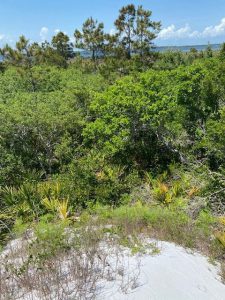
From atop of one of the higher dunes you can see the steep drop towards the marsh.
Along the ridge between the maritime forest and the salt marsh is where I found the otter slide last month. I did not see any evidence of otters today. The bird action was slower today as well. Maybe because of the heat they too had settled somewhere. I did not see an osprey, which is unusual.
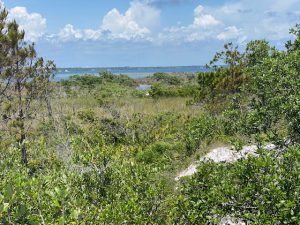
Big Sabine as seen from atop one of the larger dunes.
As I reached the beach of the Sound, I did notice a LOT of digging by armadillos. They had been very active. There were no snakes or marsh rats. There were again people, these were on jet skis. There were a few fishing from small boats. With no rain over the last week or so the visibility in the Sound was amazing, but I only saw one small blue crab. No hermit crabs and not any fish. However, the lagoon of the marsh the killifish, also known as bull minnows, were abundant and the males all aglow with their iridescent blue colors of breeding season. The males were chasing each other all over the tidal pools and open water of the lagoon designating their territories for current breeding that would follow. I did notice more crows than I usually do and what made me catch their attention was the constant calling at me and the hovering over me suggesting they too were breeding, and an active nest was nearby.
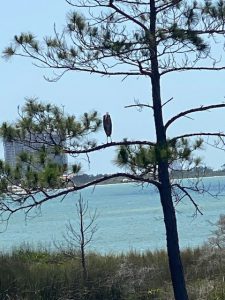
A blue heron is seen sitting in a pine overlooking Santa Rosa Sound.
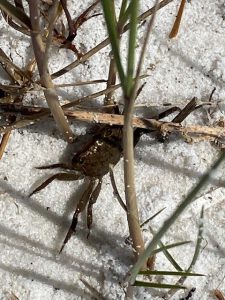
A small Seserma crab is seen hiding under grass along the beach of the Sound.
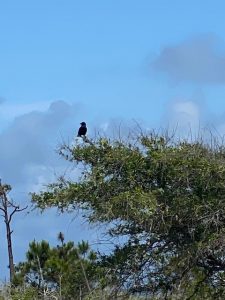
The crows were numerous and active on this spring afternoon.
I was not expecting much hiking in the middle of the afternoon, but it is always good to do these just to see what is moving. I hope to do another hike this month either early in the morning or late in the afternoon. Maybe we will see more.
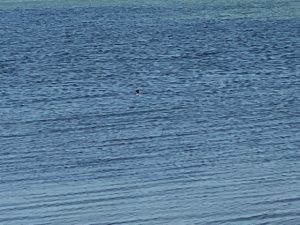
It may be hard to see, but there was a small duck enjoying the Sound.
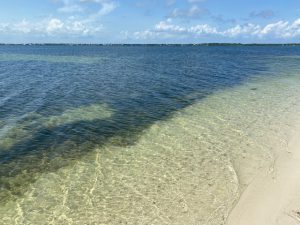
With little rain over the last few days the water clarity was excellent and you could see the seagrass very well.
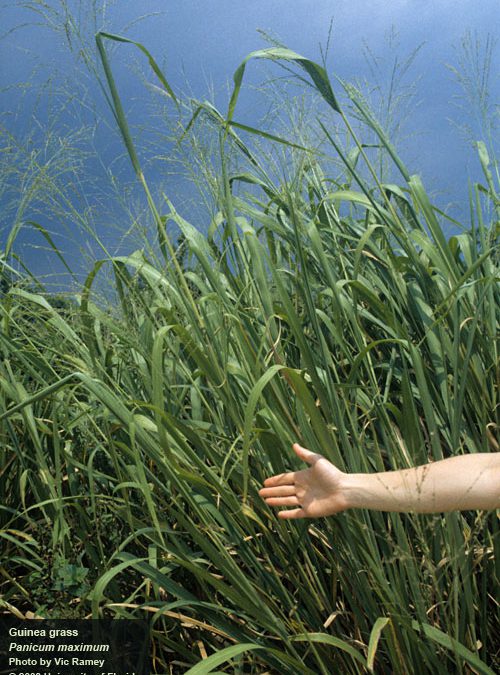
by Rick O'Connor | May 13, 2022
EDRR Invasive Species
Guinea Grass (Megathyrus maximum)

Guinea Grass
Photo: University of Florida IFAS
Define Invasive Species: must have ALL of the following –
- Is non-native to the area, in our case northwest Florida
- Introduced by humans, whether intentional or accidental
- Causing either an environmental or economic problem, possibly both
Define EDRR Species: Early Detection Rapid Response. These are species that are either –
- Not currently in the area, in our case the Six Rivers CISMA, but a potential threat
- In the area but in small numbers and could be eradicated
Native Range:
Guinea grass is native to Africa.
Introduction:
The plant was introduced as livestock fodder.
EDDMapS currently list 2,614 records of guinea grass. Most records come from Florida and Texas, but it has also been reported in Hawaii and Puerto Rico. In Florida it has been reported across the state. There are 17 records in the Florida panhandle, 15 of those within the Six Rivers CISMA, 12 of those within the CISMA were reported from the Yellow River Preserve area in Santa Rosa County and the remaining three were from Eglin AFB.
Description:
This is a large panicum grass reaching heights of up to seven feet and grows in dense mats. The strap-like blades and smooth and up to three feet long and two inches wide. The seed inflorescence is large as well, reach two feet in length.
Issues and Impacts:
Guinea grass is an aggressive growing plant that will quickly occupy disturbed open spaces and form thick monocultures decreasing native plant abundance and overall biodiversity.
Management:
The recommended management is foliar spraying with a 1% solution of glyphosate. Care should be taken not to overspray because this herbicide is non-selective and will kill other desirable plants.
Please report any sighting to www.EDDMapS.org
For more information on this EDRR species, contact your local extension office.
References
Urochola maximum. Guinea Grass. University of Florida Center for Aquatic and Invasive Species. | Center for Aquatic and Invasive Plants | University of Florida, IFAS (ufl.edu).
Sellers, B., Smith, H., Ferrell J. 2018. Identification and Control of Johnsongrass, Vaseygrass, and Guinea Grass in Pastures. University of Florida Electronic Data Information System. SS-AGR-363. pdf\AG\AG372\AG372-16272415.pdf (ufl.edu)
Early Detection and Distribution Mapping System (EDDMapS)
https://www.eddmaps.org/
Six Rivers CISMA
https://www.floridainvasives.org/sixrivers/
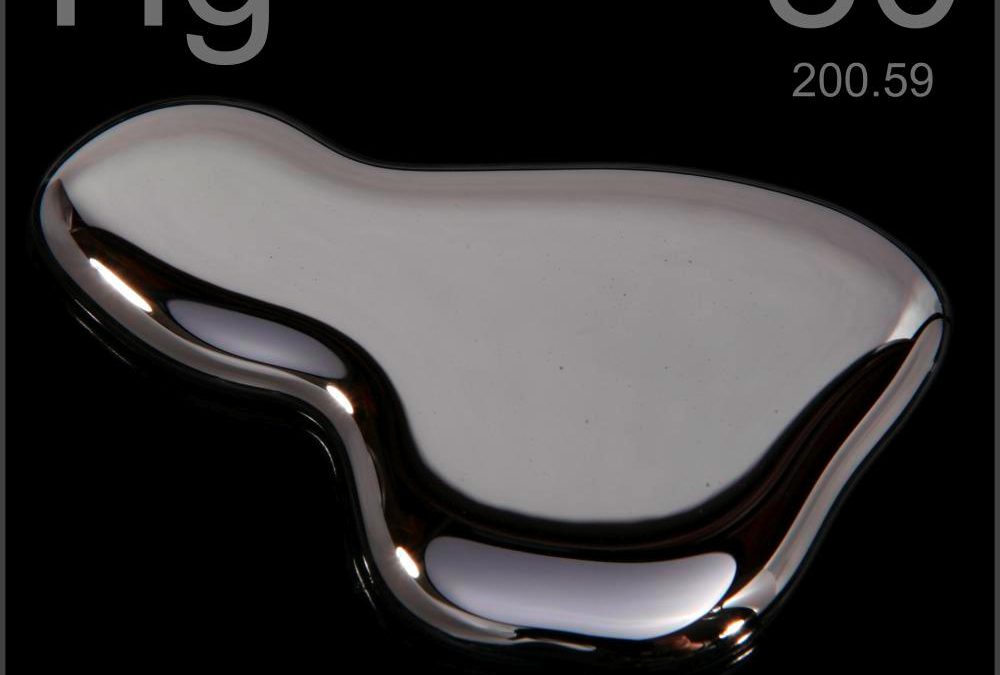
by Rick O'Connor | May 6, 2022
Imperiled (verb) – put at risk of being harmed, injured, or destroyed.
In 2021 the Florida Department of Environmental Protection classified 44 area waterways in the Pensacola Bay System as imperiled. Such designations are based on an environmental parameter making it unhealthy for one reason or another. When we think of an unhealthy body of water, many times we think of sewage. There are nine bodies of water in the Pensacola Bay System classified as imperiled due to the fecal bacteria concentrations within. There are another seven for bacteria levels high enough to close them for shellfish harvesting. This is a total of 16 bodies of water having bacteria issues (36% of the 44 designations).
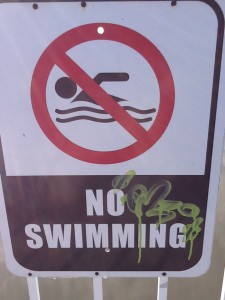
Closed due to bacteria.
Photo: Rick O’Connor
Low dissolved oxygen and fish kills is another parameter we think of. There are four waterways designated imperiled due to high nutrients (a cause of hypoxia and fish kills), and one for low dissolved oxygen readings itself. This is a total of five (11% of the 44 designations).
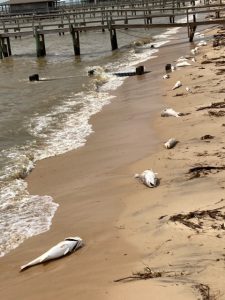
Dead redfish on the eastern shore of Mobile Bay.
Photo: Jimbo Meador
But you may be surprised to learn that 23 of the 44 imperiled water bodies (52%) are designated based on the mercury content of the fish sampled there.
Most people are aware of the mercury issue in fish. Many of those living in the Pensacola Bay area are aware of this issue locally, but they may not be aware that with the 2021 designations, it is the primary reason for many listed. To be fair, it is not that mercury issues are increasing, it may be more that there are 97 waterways in the Pensacola Bay System being considered for delisting in 2021 and those are listed for a variety of other issues. What it is stating is that with the 44 that remain imperiled, mercury is the primary cause.
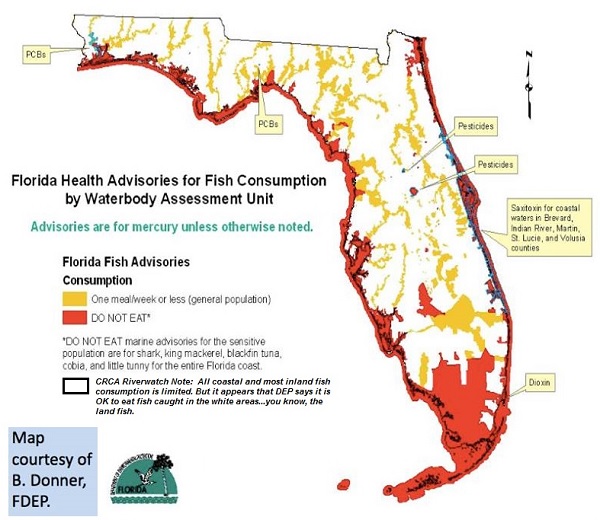
We have all heard of mercury in fish, but where is it coming from? What health problems does it cause? And is there anything that can be done to make these bodies of water healthier?
Mercury is a naturally occurring element on the periodic table. It is element #80, meaning it has 80 protons and electrons, one of the larger naturally occurring elements. It is a silver-colored liquid at room temperature, one of only two naturally occurring elements in the liquid phase at these temperatures – the other being bromine. It is sporadically found throughout the earth’s crust, usually combined with other elements. There are two forms of mercury – mercury (I) and mercury (II) – indicating the number of cations available for sharing or transferring in compound bonding. Mercury (II) is more common in nature.
The element has been of interest to humans for centuries. There are records of it buried beneath the Mayan pyramids, though we are not sure how it was used, and it was used in Chinese medicine centuries ago. The Spanish used it to help extract silver from mines during their colonial period around the world. It was also used in separating fir from skin in felt hat making in the 19th century. Hatters who used this method eventually had neurological problems and became known as “mad hatters”, an idea used in Lewis Carol’s Alice’s Adventures in Wonderland.
In more modern times it has been used in fillings for tooth cavities (including my own) and preserving specific vaccines. Being a good conductor of electricity and not of heat, it is used in numerous electrical components, fluorescent lighting, and batteries. Some cultures used it to help “whiten their skin” and a common use is in the processing and production of certain industrial chemicals. Today, due to the toxic properties of mercury, many of these uses are no longer.
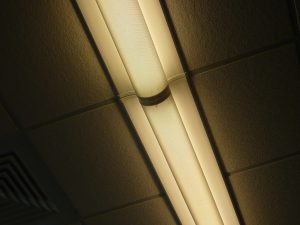
Fluorescent lighting contains mercury.
Mercury is obtained for these uses by mining their ores. The most sought after ore is cinnabar, a red-colored rock found around the world. Mercury (II) sulflide (HgS) is a common compound found in cinnabar. When heated and oxidized it will produce sulfur dioxide and elemental mercury.
HgS + O2 à Hg + SO2
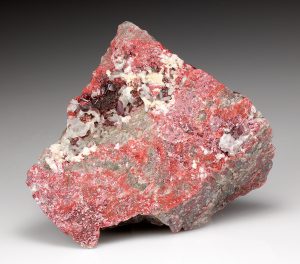
Cinnabar is the most common ore mined for mercury.
Photo: Classic Crystal
The problem with mercury is that it is toxic, and some forms of mercury are more toxic than others. The element is known to cause brain, kidney, and lung issues. It also can weaken the immune system. It is most known for the neurological problems it causes. Sensory impairment, lack of motor skill coordination, psychotic reactions, hallucinations, tremors and spasms have all been connected to exposure to mercury. There are concerns with the neurological development within the fetus if exposed to mercury and many of the health advisories target women of childbearing age who are pregnant or considering it. They have included the very young and the very old in their recommendations that these members of the population do not eat more than 6 ounces of fish (or shellfish) that have high mercury contamination.
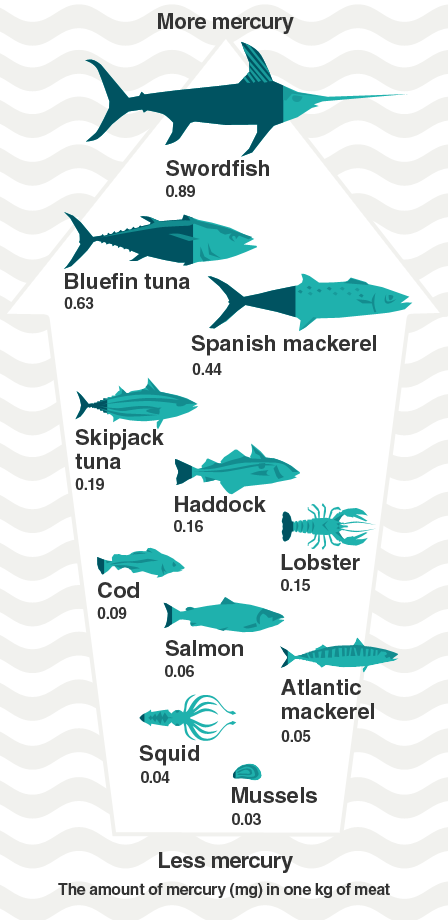
Mercury contamination in fish.
Image: BBC
The organic forms of mercury, dimethylmercury and methylmercury, are the more toxic forms. These are introduced to the environment both naturally and from human activity. Once in the aquatic environment they are absorbed by the phytoplankton (microscopic plants in aquatic environments). Methylmercury accumulates in lipids (fats) within the cell at relatively low concentrations (phytoplankton are not large). However, they are not passed by the creature. The slightly larger zooplankton (microscopic animals) feed on the phytoplankton and accumulate the mercury they have stored. Feeding on a lot of these, they accumulate even more mercury. The zooplankton are consumed by small fish, who eat a lot and accumulate even more mercury. Then the mid-sized fish consume them, and the larger fish consume those, and on and on. The top predators have accumulated enough methylmercury to be hazardous to human health IF they are consumed by people. This process of increasing the concentration of mercury through the food chain is known as biomagnification – “magnifying the problem”.
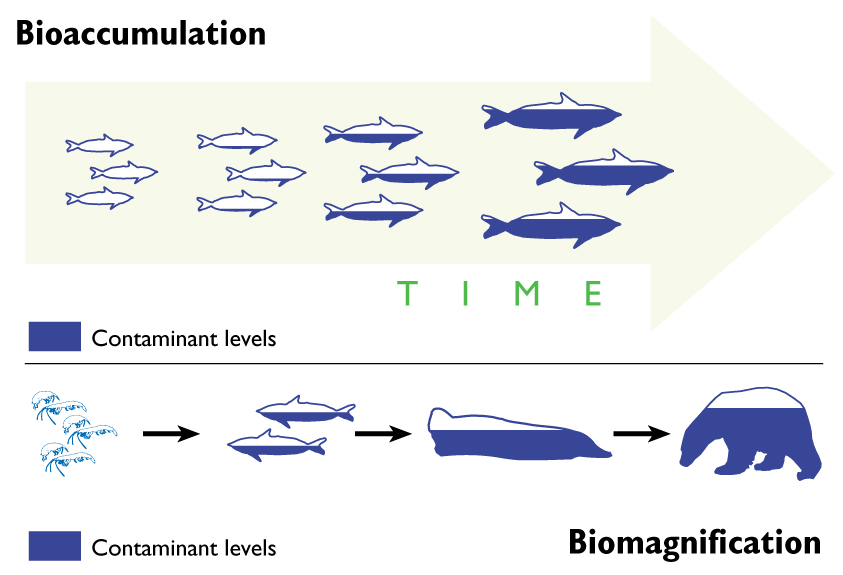
So, which fish are of concern?
Based on the Florida Department of Health for freshwater systems in Escambia County.
- Bluegill, Channel catfish, Largemouth bass, Long-eared sunfish, Red-eared sunfish, Spotted sunfish and Warmouth from the Escambia River system – you should not eat more than one/week.
- Do not eat chain pickerel or largemouth bass – and do not consume more than two red-eared sunfish from Crescent Lake.
- Lake Stone near Century FL – no more than two bluegill and sunfish per week and no more than one largemouth bass each week.
- From the Perdido River do not eat more than two bluegill or sunfish each week and do not eat largemouth bass from the Perdido River.
- The same species and regulations apply for the Yellow River system as well.
The following marine species are of concern….
Almaco jack, Atlantic spadefish, Atlantic croaker, Weakfish (trout), Black drum, Black grouper, Blackfin tuna, Bluefish, Cobia, Dolphin, Pompano, Gafftop catfish, Gag, Greater amberjack, Gulf flounder, Hardhead catfish, King mackerel, Ladyfish, Lane snapper, Bonito, Mutton snapper, Pigfish, Red grouper, Red snapper, Sand seatrout, Scamp, Shark, Sheepshead, Snowy grouper, Southern flounder, Southern kingfish, Spanish mackerel, Spot, Striped mullet, Vermillion snapper, Wahoo, White mullet, Yellow-edge grouper, and Yellowfin tuna.
In each case it is not recommended eating more than two servings a week. For a few, it is recommended that the most vulnerable people mentioned earlier not at ANY… Those would include Blackfin tuna, Cobia, King mackerel, Bonito, and Shark.
It is recommended that NO ONE eat king mackerel over 31 inches and any shark species over 43 inches in length.
I guess as you look at this list, you see fish species that you like. This list can lead folks to think… “I am just not going to eat seafood”. This would be a mistake. The Department of Health has found there are essential vitamins and nutrients provided be seafood that are missing if you do not eat them. They found additional problems in fetal development when seafood protein was left out of the mothers’ diet. So, the response would be… eat other seafood species you do not see on this list… or, if you see something you do like, no more than 1-2 6-ounce servings per week.
So, is there anything we can do about the mercury issue in our bay system?
Well, to have the biggest impact you will need to determine the biggest source. 33% of the mercury in our environment comes from natural sources, such as volcanic eruptions. We can do nothing about volcanic eruptions, or other natural sources, so we will need to look at anthropogenic (human) sources.
The larger sources would be anthropogenic, which account for 67% of the known mercury in the environment, focusing on these can make a large impact. Coming in at No.1 – producing electricity by burning coal. This accounts for 65% of the anthropogenic sources. Moving away from burning coal would make a huge difference. But that is easier said than done. Mining and burning coal are important for the economy of many communities. It is one of the cheaper methods of producing much needed electricity. But in addition to producing mercury compounds during the heating process, many other toxic compounds are produced and released as well – not to mention the amount of greenhouse gases produced during this process. Hence the name “dirty coal”. There are other methods of producing electricity and the solution would be to convert not only the power plants to these methods, but the coal dependent communities to this line of work. This one step would make a big difference.
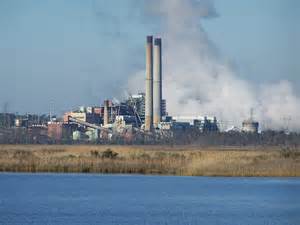
Power plant on one of the panhandle estuaries.
Photo: Flickr
At a much smaller scale, mining for gold produces 11% of the mercury from the mine tailings, cement production (7%), and incinerating garbage (3%). Though not a large player in this game, reducing the amount of solid waste burned each year would help reduce the mercury issue.
The takeaway here is that the number of imperiled waterways in the Pensacola Bay System have been reduced over recent years and we will look at this in another article. But for those that remain, mercury is the prime reason. It is also important to understand that mercury is a naturally occurring element and can not be broken down, so we have what we have – but, we can stop adding to the problem. Third, eating some seafood each week is good for you. You will just need to select species that are not problems or watch how much you eat if you prefer some of the listed species.
For more information on the 2021 imperiled waterways list visit
https://floridadep.gov/dear/watershed-assessment-section/content/final-lists-impaired-waters-group-4-cycle-2-basins
For more on the seafood safety species lists visit
https://dchpexternalapps.doh.state.fl.us/fishadvisory/
Other sources for this article included:
Wikipedia – https://en.wikipedia.org/wiki/Mercury_(element)
Miller, G.T., Spoolman, S.E. 2011. Living in the Environment. Brooks and Cole Cengage Learning. Belmont CA. pp. 674.
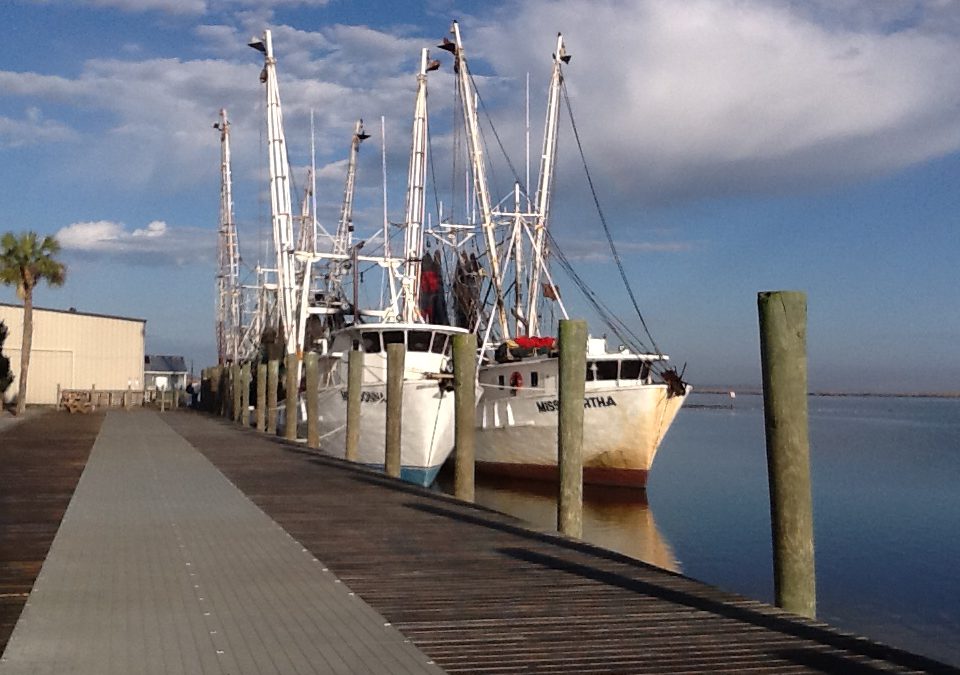
by Rick O'Connor | Apr 29, 2022
I recently saw a news clip about a new Florida Fish and Wildlife Conservation (FWC) ruling for shrimpers. I was interested in this new ruling but also asked the question – “Where did all of the shrimpers go?”
What I mean by this is that when I was young there were shrimp boats on Pensacola Bay every evening. They seemed to trawl one side of the Pensacola Bay Bridge or the other, but you could see the lights on the decks of each trawler and there were many, looking like front porch lights of a small community, all over the bay. In the morning they would head towards the seawall along both sides of Palafox Street near the old Pensacola Municipal Auditorium and sell from the boats. We made frequent trips there.
Then the boats stopped coming to the docks…
And the Municipal Auditorium is now gone also…
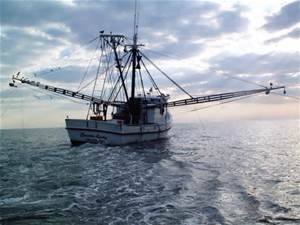
Shrimping in the Gulf of Mexico.
Photo: NOAA
The focus turned to the docks near Joe Patti’s. Joe Patti’s, American, and Allen Williams Seafood companies were places we would frequent to purchase shrimp when they came in. Then those slowly disappeared with only Joe Patti’s remaining open to the public. The shrimp boats still come to the docks of Allen Williams, but in fewer numbers and the shrimp began to go through Joe Patti’s, Maria’s, Perdido and other seafood markets. Now the lights on the bay at night are few. Actually, I rarely see them anymore. Where did they go?
As you look at the commercial landings of shrimp since 1980 you see some interesting trends.
First, understand that commercial landings mean this is where the shrimpers “land” their catch, not where they caught it.
Second, that brown shrimp (bay shrimp) are BY FAR the most landed species in Escambia County. Comparing brown shrimp to white (also called Gulf shrimp), rock shrimp, and royal reds, there was a total of 13,372,791 lbs. of brown shrimp landed between 1984 and 2019. For the others white shrimp was 255,587 lbs., royal reds 95,920 lbs., and rock shrimp 78,817 lbs. You could also say the same for effort. Between 1984-2019 there were 31,935 trips for brown shrimp, 904 for white shrimp, 143 for rock shrimp, and only 19 for royal reds. So, brown shrimp are king for commercial landings here.
Third, there were 1000 or more trips per year for brown shrimp until 2002. That year it dropped to 835. In 2003 that was cut in half to 453 and the trend continued to decline. Between 2017-2019 there were less than 100 trips each year. There is a similar pattern for white shrimp. Prior to 2002 the number of trips for white shrimp were in the double digits, occasionally in the triple, each year. In 2002 it dropped from 38 to 7 per year and never recovered. Though royal reds and rock shrimp were never big players in local landings, between 2010 and 2019 there was only one trip for rock shrimp and no trips were logged for royal reds. What happened?
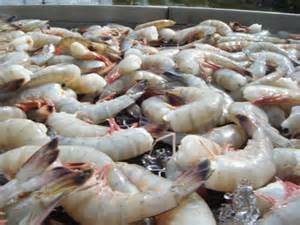
The famous Gulf Coast shrimp.
Photo: Mississippi State University
To try and find answers I reached out to a couple of my seafood contacts. Teresa and Bob Pitts are from the Perdido Key area and have been involved with commercial fishing most of their lives. Teresa currently manages Perdido Seafood and Bob works with the National Park Service but they both have strong ties to this industry. Jimbo Meador is a lifelong resident of Mobile Bay and has been involved in several industries including seafood over there. Jimbo recently retired from being nature tour operator in the Mobile Delta but still has ties to the seafood business and a wealth of knowledge. Dr. Andrew Ropicki is an economist with Florida Sea Grant and the University of Florida who focuses on seafood and other marine related topics. I had a conversation with all, and comments were made that helped connect some the dots.
In 1995 the state imposed a net ban on all entanglement nets 500 ft2 or larger from state waters. This obviously would have included Pensacola Bay. I know the shrimpers were opposed to this amendment. They were very visible and vocal about it. Once passed it would make sense they would move their operations from Pensacola Bay to Alabama, or federal waters offshore, so they could continue to use their standard sized otter trawls. Honestly, I do not remember which year the deck lights of the shrimp boats began to disappear, but I would guess many did leave when this law was passed. However, this did not impact the number of landings, they continued to bring shrimp here.
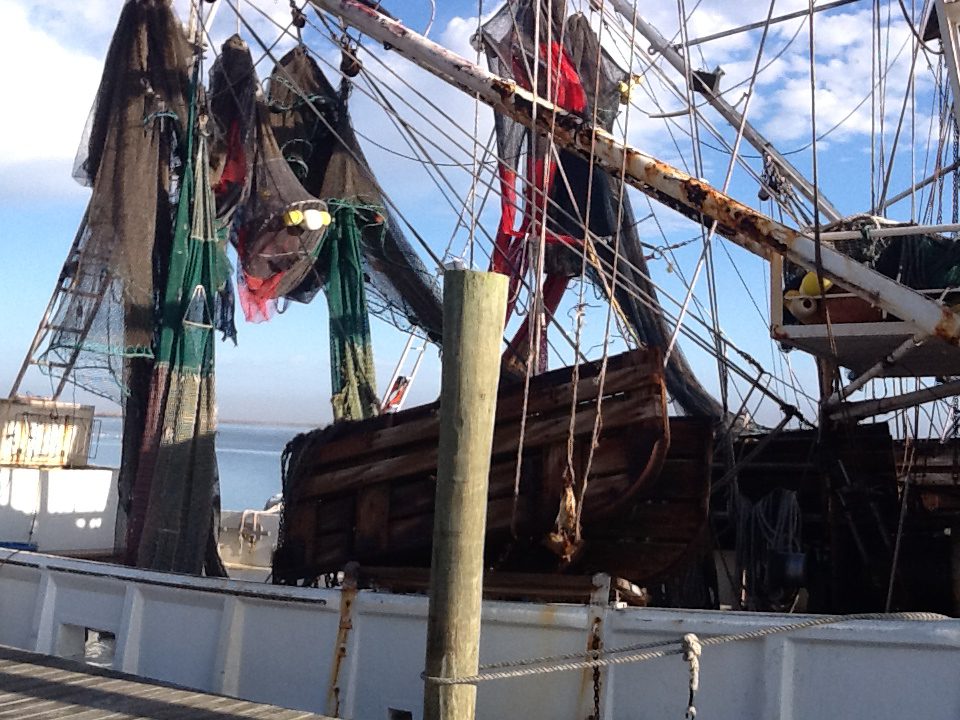
Otter trawl is correct name for what folks call a shrimp net. In 1995 any entanglement net over 500 square feet were banned in Florida waters.
Prior to 1995 landings of brown shrimp ranged from 1114 to 2523 a year with an average of 1760. Between 1995 and 2000 the range was from 1134 to 1816 with an average of 1442. A slight drop, but nothing significant. If they were shrimping somewhere else, they were still landing in Escambia County. I recently had a conversation about this with Bob Jackson, one of my citizen science volunteers. He moved here around 2000 and remembered shrimp boats still being on the bay at that time. Some may have moved due to the net ban, but not all. The shrimping was still on.
In 2002 the landings did take a significant drop – 835 landings that year. The first time they were below 1000/year since the records were kept in 1984. In 2003 they dropped further to 453 and the decline has continued ever since. Where were they landing their shrimp? Were they still shrimping? I do not know.
Jimbo asked the question “when did the surge of foreign imports begin?” Good question. We know now that at least 80% of the seafood consumed in Florida is imported. When did this move from local to import make this big swing? Dr. Ropicki found a world shrimp production graph that showed 2003 as a year with a big increase in aquaculture shrimp. Aquaculture accounted for 28% of global shrimp production in 2000 and 55% in 2010, and that is with wild caught shrimp increasing slightly. The big swing towards aquaculture in 2003 closely mirrors the decline in local wild harvest landings in 2002. This certainly could be a piece of the puzzle.
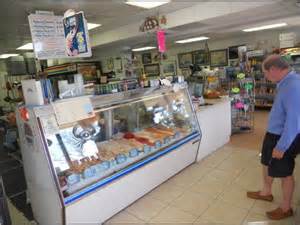
Seafood markets offer local products as well as those from around the world.
Photo: Florida Sea Grant
Did this competition with imports create less effort on the part of local shrimpers?
It certainly had some impact. All of my contacts indicated that the price difference between imported and local seafood made it much more difficult to do business. Add to this the rise in cost of fuel, insurance, and regulations to the industry, some captains did sell their boats and found another line of work.
Looking at the fuel story, Dr. Ropicki found a chart published by the U.S. Energy Information Administration. The chart shows how Gulf coast #2 diesel prices have changed since 1995. Basically from 1995 to 2021 they tripled (200% increase) while general inflation was only about a 75% increase. As many know it is a very fuel intensive industry.
In 2004 Hurricane Ivan hit our area and that certainly would have caused a decline in landings due to damage to boats and docks. The number of landings that year was 388. Between 2004 and 2010 landings steadily declined from 388 to 155/year. The days of 1000+ landings seemed to be over. Many shrimpers lost their boats during the storm and just found another line of work.
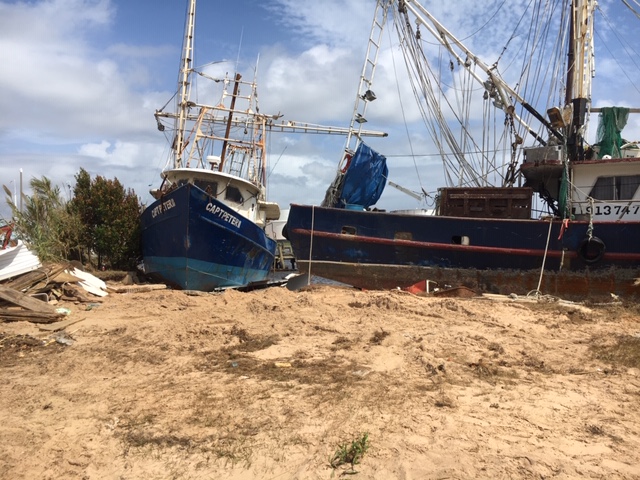
Hurricanes are one reason some shrimpers have left the business.
Photo: Rick O’Connor
To add fuel to the fire, in 2010 the Deepwater Horizon oil spill occurred. That year there were only 85 landings in Escambia County, the first year we had less than 100. But we understand why – no shrimping occurred with oil in the water. Many shrimpers still in the business were hired to help clean up the spill, and did make money doing it, but they were not landing shrimp.
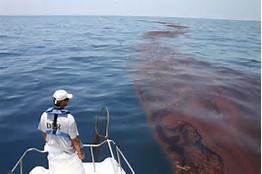
The BP Oil Spill was one of the worst natural disasters in our country’s history.
Photo: Gulf Sea Grant
In 2011 landings returned to 187 for the year and even up to 235 in 2012, but since there has been again a steady decline. In 2017 we went below 100 landings again. Between 2017 and 2019 the landings in Escambia County were 66, 53, and 70 respectively – the lowest ever. FAR below the 1000-2000 landings in the 1980s and 1990s.
Further discussion with my contacts yielded another trend. Commercial fishing historically was a family venture. Families worked the boats and sons took over the business from their fathers. That seems to have stopped. One shrimper who did talk to me said at one point we had between 40-50 boats in our fleet, now there are 11 and their kids want nothing to do with the business. As one of the contacts mentioned “they would rather work with their brains than their backs”.
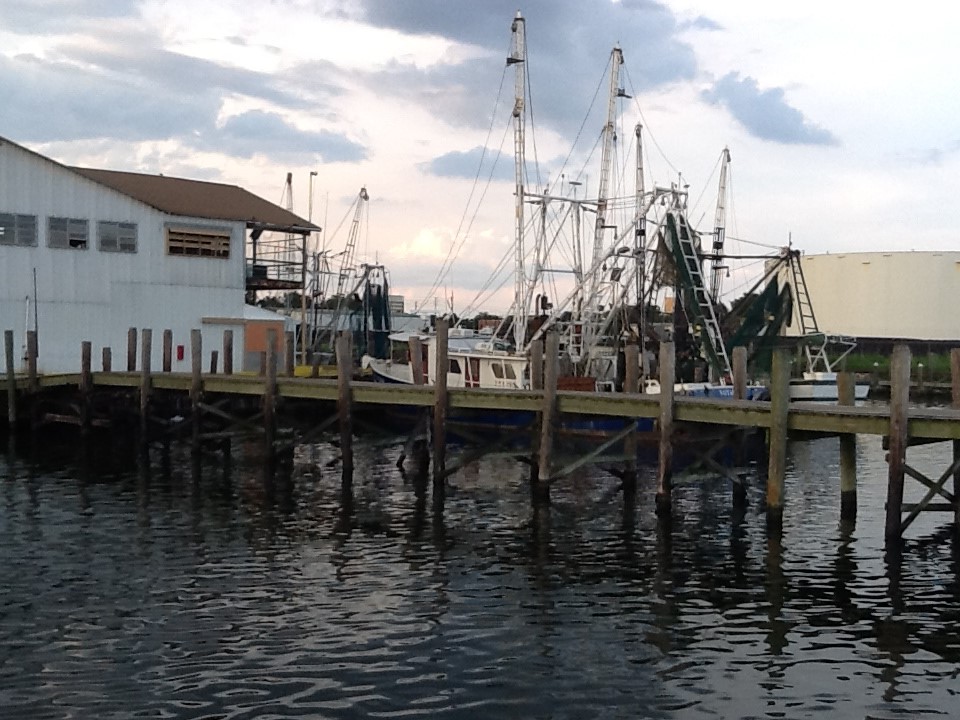
Commercial seafood in Pensacola has a long history.
Photo: Rick O’Connor
In Alabama many families actually lived on their boats and the entire family would go out when the shrimping was on. I was told they do not see this anymore. There are still some bay shrimpers who sell their catch along the Hwy 90 causeway crossing Mobile Bay, and they seem to be doing well, but there are fewer of them. I was also told that many of the Gulf shrimp boats in Alabama have been sitting idle at dock for several years, many are up for sale, and it has been primarily foreign businesses buying them. There were once 120 Gulf shrimp boats in the fleet at Bon Secour Seafood, now there is one. I recently heard a Pensacola shrimper who made port in Bayou Chico – just sold his boat this year.
Dr. Ropicki also shared data on price for shrimp. Could this play a role in this story?
Most commercial seafood products have seen an increase in purchase price at the dock, but not shrimp. Checking the state records for price/pound for brown shrimp in Escambia County found some interesting trends. Between 1985 and 2020 the average price paid for their harvest was between $1.50 and $2.00 a pound. At least once each decade the price went to $2.00 or more per pound – but only ONCE each decade. In that time the number of years where the price dropped BELOW $1.50 per year steadily increased. Between 1985-89 the price dropped below $1.50 only once. Between 1990-1999 it never dropped below. Between 2000-2009 it dropped below $1.50/lb. six times. This happened again between 2010-2019 – six times. In 2006 local shrimpers only got $1.01/pound for the work – the lowest in this data set. If you look at the average price a shrimper received for their brown shrimp harvest by decade you see…
1985-89 – $1.82
1990-1999 – $1.78
2000-2009 – $1.58
2010-2019 – $1.54
A steady decline over time. Along with storms, regulations, fuel costs, lack of labor, and competition with imports, you can add price to the “soup of problems”.
I was curious if a similar scenario was playing out in Apalachicola. Apalach is known for their oysters, but there is a sizable shrimping industry there as well – it’s a seafood town. I asked our Sea Grant Agent over there, Erik Lovestrand, about similar trends. He did not have any data but was reasonably certain that the number of boats working out of their docks had significantly declined over the years.
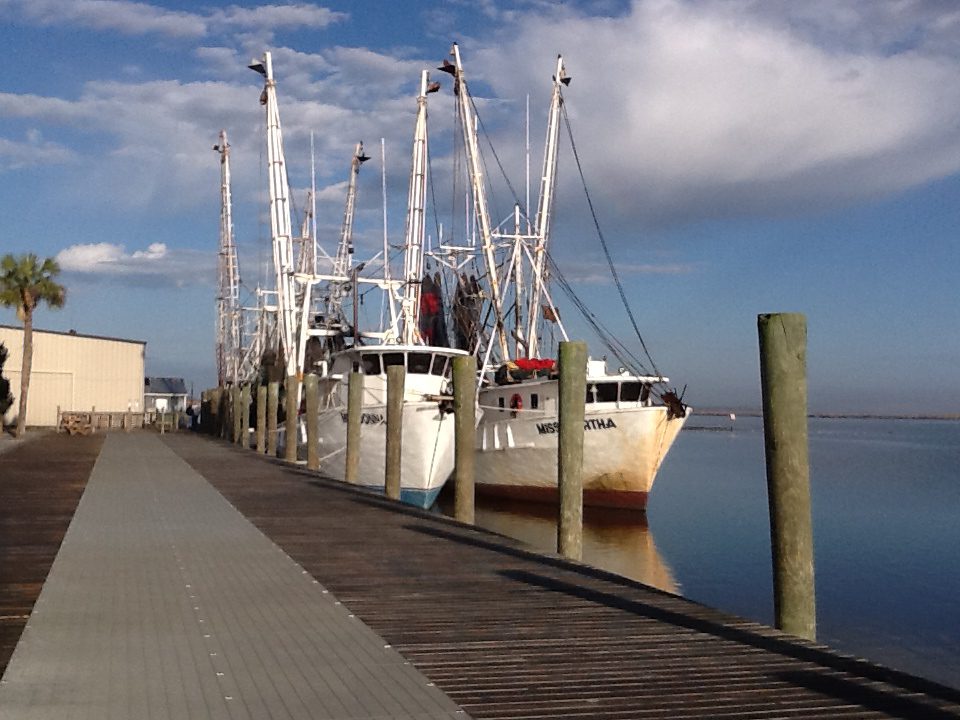
Known for their oysters, Apalachicola is also a shrimping town.
I decided to take a look at the landing numbers for Apalachicola. I looked at brown shrimp.
Between 1985-1989 they averaged 909 landings – less effort for this species than in Escambia County.
Between 1990-1999 there averaged 1546 landings a year.
Between 2000-2009 the average was 382.
And between 2010-2020 it was 68.
The pattern looks similar albeit the number of landings was brown shrimp were less in Apalachicola. However, I did see another interesting difference – price paid per pound. In Escambia over this time the average price was $1.66/pound. It only went to $2.00/pound once decade and began to drop below $1.50 frequently over the last 20 years. However, in Apalachicola the average price was $2.00 rarely going below that and even reached $3.32/pound in 2014. They pay more for brown shrimp in Apalach. I am not sure if that impacted landings locally. The data suggests that it did not, but it is interesting.
And then, another thought came to mind. From the Big Bend of Florida south to Key West pink shrimp, not browns, are the target species. What did the pink shrimp landings look like? Did Escambia make a switch?
The results were interesting. Between 1985-2021 the landings of pink shrimp in Apalachicola occurred every year. The total number of landings was 6431 and averaged 174/year. The price was good, ranging from $1.80 to $3.23/pound, the average price was $2.39. The number of trips per year never broke 500 and the trend on landings shows a decline over this time period. But the price was decent for those who chose to target this shrimp.
In Escambia County the effort was low. They did not continuously land pink shrimp each year, but rather over short periods. Landings occurred between 1986-1991. Then nothing until 1997. Then another short period from 2000-2003. Then nothing again until 2014, which ran until 2020. Other than in 2000, the number of trips for pink shrimp were less than 10 a year (they were 10 in 2000). The average number of trips since 1986 was 4/year – less than Apalachicola and much less that the brown shrimp harvest here.
However, the price per pound was much higher for pink shrimp in Escambia. It ran from $1.59 to $5.00/pound! The average price was $2.77 (more than what they were paying in Apalachicola). Though Escambia landings were not big for pink shrimp, it was certainly more profitable than brown shrimp.
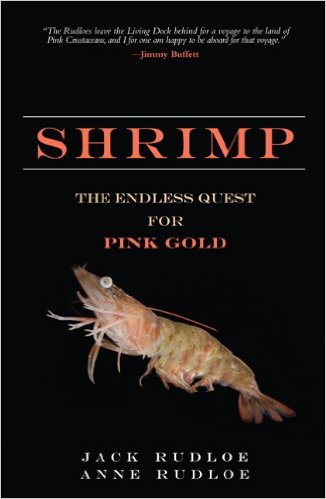
Pink shrimp are very popular.
All of the above played play a role in the decline of the local shrimping industry. However, if you visit a local seafood market you will find shrimp. Some is still local, local landings may be down, but they have not stopped. Some are local in the since they were harvested elsewhere in the Gulf of Mexico and trucked to us. But as we mentioned, cheaper imports are easier to get. So, it does not seem we are going to run out of shrimp, just out of shrimpers. For some it is unnerving that we will be dependent on other countries for our seafood, but we will have seafood.
Which brings up the topic of aquaculture. This is for another article. Until then, we do encourage you to enjoy seafood, it is a healthy source of protein. We will see where the local industry heads in the next decade, but you can still get shrimp, and I have seen nice looking ones in there. Enjoy them.
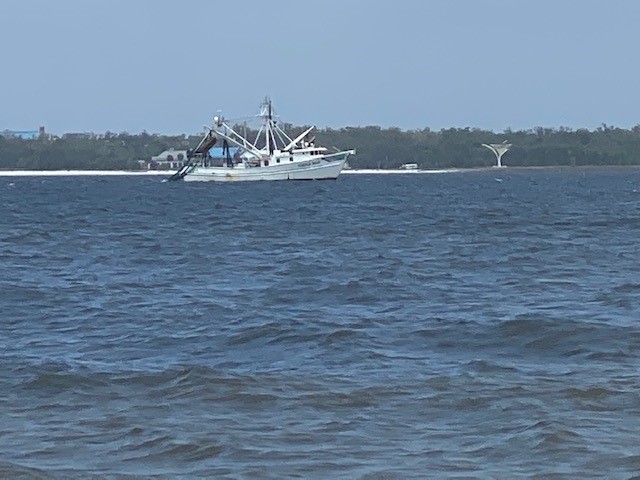
A rare site – a shrimping landing its catch in Pensacola Bay in 2022.
Note: After completing this article I had a meeting in Bayou LaBatre AL. I was told that shrimping industry there was hanging on… barely. Also, the high school teacher I met with said he was not aware of one kid in the school who planned to become a shrimper… this is in Bayou LaBatre Alabama.
Special thanks to
Bob and Teresa Pitts – Perdido Bay Seafood
Jimbo Meador
Dr. Andrew Ropicki – University of Florida / Florida Sea Grant
Erik Lovestrand – UF IFAS Extension / Florida Sea Grant / Franklin County
Bob Jackson













































